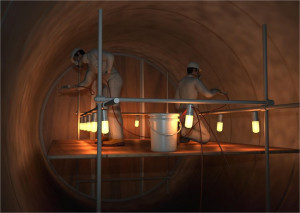A flash-fire inside a permit-required confined space at a hydroelectric plant in a remote mountain location killed five and injured three workers. Industrial painting contractors were in the initial stages of recoating the 466-m steel portion of a 1,311-m enclosed penstock tunnel with an epoxy coating product. Shortly after the epoxy application commenced, the work crew experienced problems with the spraying process, resulting in poor coating quality. Spraying was terminated and the crew began cleaning the sprayer system equipment with a flammable solvent, methyl ethyl ketone (MEK) to remove epoxy residue before taking the equipment out of the penstock. During this cleaning operation, MEK vapours inside one of the two epoxy hoppers ignited, likely from a static spark, and flashed. The resulting fire grew quickly, consuming several other open containers of MEK (about 60 L) and numerous buckets of epoxy material positioned around the sprayer. Four crew members positioned on the side of the fire nearest the single exit evacuated the penstock, although three were later treated for injuries: one received minor burns, one fractured his arm, and another suffered breathing difficulties. Five additional crew members trapped opposite the exit were unable to evacuate due to the fire and narrow configuration of the penstock.
Fourteen community emergency response teams responded to the incident, but due to poor organisation (no certified confined space rescue responders neither on site nor in the state of Colorado) and initial information, the rescue could not respond in due time. The 5 trapped workers communicated using handheld radios with co-workers and emergency responders for approximately 45 minutes before succumbing to smoke inhalation.
The investigation carried out by the US chemical safety board (CSB) found that a number of safety issues contributed to the accident, including a lack of planning for hazardous work, inadequate contractor selection and oversight, and insufficient regulatory standards pertaining to the use of flammables within confined spaces. Indeed, no hazard evaluation of the epoxy recoating work had been carried out and the company and its contractor failed to identify serious safety hazards involving use of flammable liquids within the confined space. The company used a confined space permit established for abrasive blasting without re-evaluating the hazards related to coating operations. Effective controls were not evaluated or implemented during their pre-job safety planning, such as substituting MEK with a non-flammable solvent. Furthermore, the majority of subcontractors had not received comprehensive formal safety training.
Finally, the contractor had been hired primarily on low price despite the lowest ranking from a technical, quality and safety perspective.




